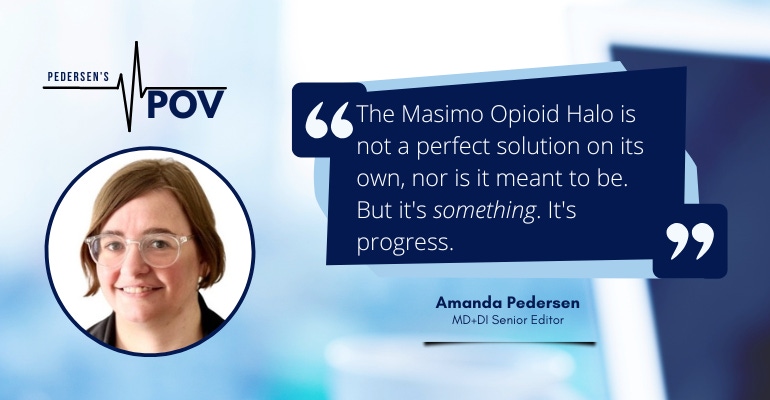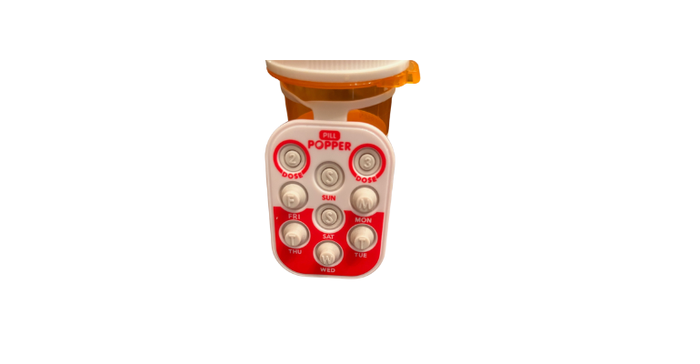This week in Pedersen's POV, our senior editor shares reader feedback on a recent FDA authorization for Masimo's wearable opioid overdose prevention device.
April 10, 2023

Last week I wrote about the Masimo Opioid Halo, a wearable system designed to detect opioid-induced respiratory depression. It's a big deal because it addresses the leading cause of death from opioid overdoses. It also coincides with the recent approval to sell Narcon over the counter, so there's a real potential for the two products together to save a lot of lives.
But boy did readers have something to say about it.
Below are just a sample of reader comments via the NewsBreak app. I'm a strong believer in using "person first" language when talking about addiction, so I've replaced stigmatizing words like "junkies" and "addicts" with the phrase "people with substance use disorder (SUD)."
"I just can't imagine any [person with SUD] wearing that. Just imagine all the skid rows everywhere. [People with SUD] have a cell phone, needle, and this new contraption. I doubt I would hire someone wearing it either. I'm with the rest of the chronic pain sufferers, we need quality of life," said a person with the username "Me."
Um, discrimination, much?
Opioid use disorder is a serious medical condition, and our society tends to forget that these so-called "junkies" are patients too.
Johnny17 argues that people with SUD either won't be able to afford the device, or they will promptly sell it to buy drugs, and several others agreed with that assessment.
Other readers thought the idea of the device "smelled fishy," while Rita L. Beckham questioned the motivation behind it – or rather the potential for the device to be used in nefarious ways.
"Fishy? Yes," Beckham wrote. "Is there a possibility of kickbacks to put people in rehab [rather than] actually trying to help very real pain patients? What is really going on?"
Still, most readers appear to be in favor of the device, judging by the number of "likes" from those who read the article via Newsbreak, as illustrated in the graphic below.

Zebra (honestly, I couldn't make these usernames up if I tried) points out that we need doctors who will prescribe the right pain meds in the adequate amount.
That is a legitimate concern, as I have experienced both ends of the pain management spectrum myself. Once, I was prescribed opioids after a simple outpatient procedure when I could have managed the pain just as effectively with Tylenol. Years later, as healthcare providers became more conscientious of overprescribing opioids, I suffered through tremendous pain during a hospital stay following abdominal surgery because my surgeon was, I believe, a little too stingy with the pain meds. But I digress.
"If you're [misusing] pain medication, please stop," Zebra goes on to say. "The government claims that's the reason they threw all of us who truly need a little relief from our severe pain to the wolves. It makes no sense, and Suboxone is not the answer for chronic pain."
It's a fair point – if only it were that simple. Unfortunately, people who struggle with addiction are rarely able to just stop without the support of a treatment program and a lot of hard work.
"Considering that the chronic pain community is at [the lowest] risk for overdose when pain is properly controlled, this contraption seems to be worthless. People with substance abuse disorder won't wear it since most 'functioning' [people with SUD] get high in secret and [people in active use] on the street don't care! Unless you plan to strictly control pain meds and a loved one's intake and don't believe the prescribing doctor's orders on how often to take the meds, then I can see how this device performance was, according to the article, 'underwhelming.' It will be again unless only used in clinical settings," writes Fedupmommabear.
For clarification, the article did not suggest the performance of the device was underwhelming, but an analyst quoted in the article mentioned that early response to the product in Europe had been described by Masimo management as underwhelming.
Alexis Hickman agreed with Fedupmommabear, but also had an excellent suggestion for the Masimo Opioid Halo.
"Only thing I could think of was for the elderly. I used to do home health and there was an old lady on her oxy multiple times because she would take it, forget she took it, and take it again," Hickman wrote. "Elderly people at home alone is the only situation I can see this being useful."
Side note, I'm just shy of 42 and I have the same problem, so I have to use this handy dandy little "Pill Popper" to remind me if I have or have not taken my daily medication.

Odds 17B asks, "Wouldn't it be easier to develop pain control methods that the [people with substance use disorder] cannot abuse?"
Funny you should ask, Odds 17B, because there has been some interesting innovation in this space in recent years. That said, there is a ton of room for more innovation to combat the opioid crisis, which is why FDA issued an Opioid Innovation Challenge in 2018. The Masimo Opioid Hero is actually the first winner of that challenge to have an authorized solution designed to help address the U.S. opioid crisis.
Seven other technologies have emerged from that challenge and are in various stages of development. Two of the winning devices are intended for pain therapy, one is intended to treat opioid use disorder, one is for medication dispensing, one is a diagnostic, one is described as a "monitoring" device, and another is simply described as "other." The Masimo Opioid Halo is the only winning device from the Opioid Innovation Challenge intended to specifically address opioid overdose.
MD+DI has also covered several devices in recent years that are aimed at the opioid crisis.
The MedicaSafe SmartKey, for example, is designed to dispense the right dose of pain medication at the right time and then it sends the data to the clinician to track patient adherence to their regimen. The NSS-2 Bridge nerve stimulator, on the other hand, doesn't specifically address pain control, but it is designed to address opioid withdrawl symptoms. Prescription digital therapeutics is a hot trend in medicine right now and Pear Therapeutics has a PDT app to help people with substance use disorder stay in recovery programs. Unfortunately, Pear just filed bankruptcy and the future of its portfolio hangs in the balance. And finally, AppliedVR has a prescription-use, virtual reality-based medical device designed to deliver pain management training.
The bottom line is this: It will take more than medication alone to win the battle against opioid addiction, and none of the technologies in development are a one-stop fix. The opioid crisis needs to be tackled from multiple angles, including pain management, opioid use disorder, and yes, overdose prevention.
The Masimo Opioid Halo is not a perfect solution on its own, nor is it meant to be. But it's something. It's progress.
It's one tool in a very large toolbox. After all, you can't build a house with just a hammer and nails – you need a variety of tools, materials, and strategies to get the job done.
About the Author(s)
You May Also Like




